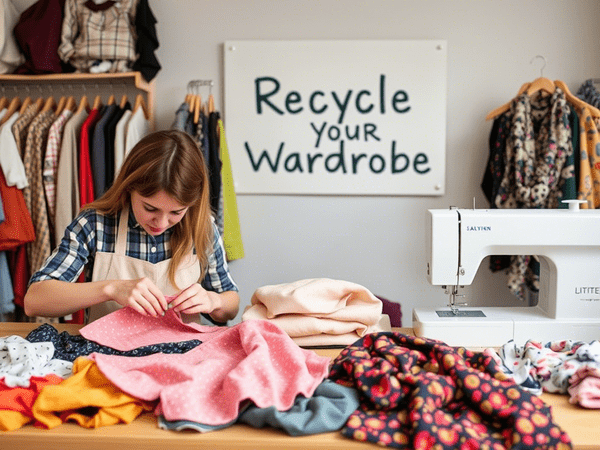5 Ways to Recycle Your Wardrobe for a Fresh Look

Fast fashion is not necessarily environmentally friendly, although it is convenient. A fashionable and eco-friendly way to change your look without breaking the bank is to recycle your old clothing. Organize your closet, express your style, and support the environment by making your wardrobe.
Mix and Match Like a Stylist
By creatively arranging various items of clothing, your perspective on your wardrobe can be changed. Especially if you are busy, wearing the same clothing over and over again is easy. But there are a lot of potential outfit combinations waiting for you in your wardrobe. Take everything out first. Hang your clothes in a visible location or lay them flat on your bed. Try wearing your favorite jeans with unexpected tops, like a crop top, blouse, or tucked-in shirt, to liven things up.
Wear tights, ankle boots, and a short sweater to transition your summer dress into the fall. Be creative with layering as well. Wear button-up shirts underneath sleeveless tops or tie shirts over dresses for a diversity of looks. Jewelry, hats, scarves, and belts are examples of accessories that change an ensemble. A basic black dress can be transformed from business-appropriate to party-ready with various embellishments. You can add interest to your ensemble by mixing various materials and designs. For example, you can match denim with silk, leather with lace, or polka dots with stripes. Look on the internet for inspiration if you are not sure of your style.
Check Pinterest boards or fashion influencers. Keep a list of potential outfits and check to see if you can create them utilizing items you already own. You will quickly discover how adaptable your clothing is. Try a one-week challenge where you wear a different clothing item every day and do not wear the same combos. This activity promotes new tastes and assists with memory recall. Also, utilizing them as clothing, trying on clothes is a way to express oneself creatively.
DIY, Modify, and Tailor Your Way to Newness
Old clothing can be transformed into brand-new looks with DIY projects and adjustments. A talented tailor can mend clothing that does not fit or feels old. They can modernize styles, change lengths, and reshape clothing. You can change your appearance by shortening a dress, defining a loose top, or upgrading a blazer. You can make old clothes your favorite again by making minor adjustments like changing the buttons, repairing the zippers, or changing the waist size.
Doing do-it-yourself projects expands your options if you have any sewing experience. Make fashionable shorts out of old jeans, or convert a sleeveless blazer or oversized t-shirt into a chic vest. Do not discard damaged clothing. Instead, try to mend them such that the repairs are visible, or apply amusing patches to transform mistakes into stylish patterns. To make your items unique, you can embellish them with embroidery, patches, or fabric paint. Tie-dying or bleach-dying an old hoodie can give it a fresh, fashionable look. There are several tutorials available on YouTube and Pinterest, ranging from simple no-sew methods for novices to more intricate crafts.
To develop a greater appreciation for your clothing, start by practicing with cheap or used things. Enhancing anything with time and effort frequently leads to increased satisfaction and care for it. You can use safety pins, fabric glue, or iron-on patches to adorn your clothing without sewing. To make your ideas a reality, work with neighborhood alteration businesses or creatives. Do-it-yourself projects allow you to sustainably express your style while saving money, giving you control, and reducing waste.
Host or Join a Clothing Swap
Swapping clothes is a bad method to renew your wardrobe at no cost and in an environmentally responsible way. Hosting a swap is simple because you can help others and trade unwanted clothing for new items. Encourage your friends, relatives, and colleagues to contribute their old clothes and accessories. Arrange things so that everyone can see and try them on, much like a tiny store. Arrange tables or clothes racks and consider classifying objects based on size or category to maintain organization.
Simplify the regulations by utilizing tickets to ensure fairness and matching the objects brought and taken. To add intrigue, pick an exchange with a theme. For fun, think about trading in your professional, vintage, seasonal, or exercise attire. By eliminating clothing waste, you can get new things, declutter, and support environmental sustainability. In a relaxed and intimate environment, it is also a good opportunity to get together and swap style tips. Don't forget accessories. Good items to take to a swap like shoes, handbags, belts, and scarves. If you prefer to do it, social networking groups and websites can assist virtual swapping with locals.
Trading, selling, and snatching goods are easy via platforms like Depop, Poshmark, or neighborhood Facebook groups. Seasons of change, child development, or vital life milestones, like a new career, are all change seasons. Sharing unwanted possessions with those who will love and enjoy them is rewarding. Clothing swaps are exciting activities that make fashion a social affair, not merely exchanging clothes. They demonstrate that you can be stylish and wise while being environmentally friendly.
Layer Smartly and Seasonally
Layering is a clever fashion trick to shift with the weather, unlocking new ways of transforming your outfits without spending money. This makes the best use of your closet space and outfit options. Through layering clothes, you can make use of your favorite pieces during different seasons. As an example, you can pair a summer dress for winter with a turtleneck along with tights, boots, and a cardigan. Cropped tops can be worn over longer shirts or dresses to dress up an outfit.
They go on top of skin with thicker garments placed on top for enhanced comfort. That feels better and looks nicer too. Combining textures and fabrics boldly, such as wearing a cotton dress with a leather jacket or a knit sweater coupled with satin pants, adds more flair to an outfit. These differences form more stylish contrasts. With layering, you are free to add larger and smaller pieces together. You can wear big coats over tight pants or tuck a thick sweater into a short skirt. Belts worn against layered outfits also help to highlight your waist, sculpting the overall look. As well as being warm, scarves, hats, and gloves can also be known to assist in effortless styling.
These accessories help transition outfits from one season to another. Lastly, don’t forget the essential pieces that provide comfort, such as thermals, camis, and bodysuits. Sort your closet for quick retrieval of tees, jackets, and other closet staples. Try with unlikely combinations to find concealed style. The style of layering lies in layering pieces together and viewing every piece as part of a larger whole. Each season gives you a chance to refresh your look and provide new life to your wardrobe with layers.
Resell and Reinvent with Purpose
Consider reselling the clothing you no longer wear or that does not suit your style to assist the environment. Disengage from fashionista mode as you find new purposes and upcycle pieces on your style adventure. Start with cleaning your closet. Purge clothes not touched in over a year, those too big or too small, or ones that no longer bring a spark. Remember the fit assessment honestly. After you reach this stage of decision, transfer to resale applications Poshmark, ThredUp, Mercari, or Vinted. It allows selling fashion pieces and accessories to other users wanting to buy secondhand pieces.
To make money from clutter, submit clear pictures, well-detailed descriptions, and reasonable prices. Buy materials to upgrade the wardrobe from the earnings. If not selling your clothes, there are other options. You can give them to local charities, women's shelters, or community centers where they can help someone in need. Work-wear donation programs exist to help people feel more confident going back to work.
The recycle bin awaits clothes that are too old or worn to sell or give away. Stores like H&M, Levi's, and The North Face have programs where you can recycle your old clothes. Many will reward your trouble with a discount or store credit. At dedicated centers, rather than simply throwing clothing pieces away, they can be recycled into cleaning rags, insulation, or other forms of filling. Not wearing something does not mean it is discarded, as ‘mixing things up’ implies. Get creative by repurposing items like using a scarf as a belt or turning a shirt into a skirt. This cuts waste, improves your style, and encourages a sustainable future.
Conclusion
You don't need to go shopping a lot to update your clothes. Create a chic, sustainable wardrobe by mixing, updating, trading, layering, and recycling clothes thoughtfully to showcase your personality. These five ways help cut down on waste and also boost your creativity and confidence. Begin today and find happiness in getting dressed again, with intention and your style.








